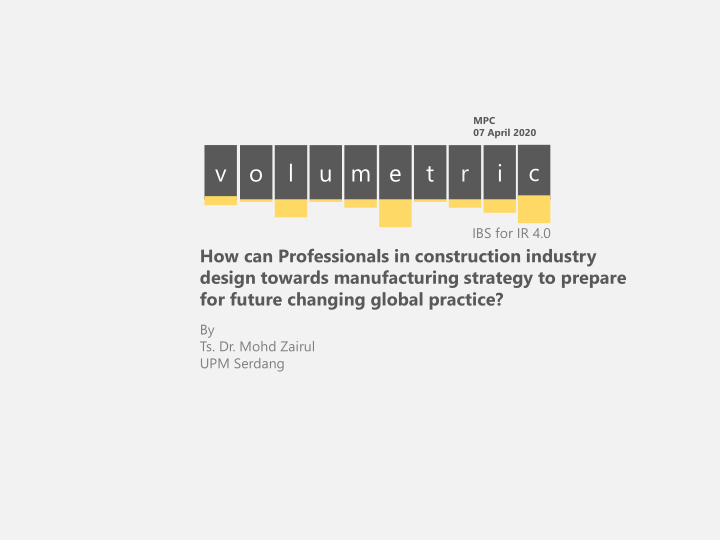



MPC 07 April 2020 v o l u m e t r i c IBS for IR 4.0 How can Professionals in construction industry design towards manufacturing strategy to prepare for future changing global practice? By Ts. Dr. Mohd Zairul UPM Serdang
SITE MANAGEMENT CRISIS DURING COVID-19 01 BACKGROUND STUDY SHORTEN CONSTRUCTION REDUCE PERIOD AND LABOUR ON REDUCE SUPPLY SITE CHAIN INCREASE SAFETY AND HEALTH IN THE WORKS ENVIRONMENT IMPACT The industry’s workforce may be vulnerable given that most of the work must take place on-site and cannot be done remotely.
DEGREE OF INDUSTRIALIZATION 01 PROBLEMS STATEMENT HIGH REPRODUCTION ROBOTIC AUTOMATION MECHANISATION LOW PREFABRICATION Richard (2005) IBS Industrialized Building System is a popular term used to characterize prefab construction in Malaysia
DEGREE OF INDUSTRIALIZATION 02 BACKGROUND STUDY MOSTLY EMPLOYED BY DEVELOPING COUNTRIES INCLUDING MALAYSIA REPRODUCTION ROBOTIC AUTOMATION MECHANISATION PREFABRICATION PRECAST CONCRETE FORMWORK SYSTEM STEEL FRAMING SYSTEM However, BLOCKWORK SYSTEM TIMBER FRAMING SYSTEM INNOVATIVE SYSTEM Malaysia only employs level 1 of industrialization of IBS in the construction industry at the moment
DEFINITION 03 BACKGROUND STUDY the ability of the same tooling which has the multi-axis flexibility to perform diversified tasks by itself machinery is employed to ease the workload of the labourer REPRODUCTION ROBOTIC AUTOMATION The research and MECHANISATION development of innovative processes is PREFABRICATION truly capable of simplifying the a situation when the production process e.g tooling (machine) totally through circular economy takes over the tasks performed by the labourer. Where are is a manufacturing process that basically takes place at a specialised facility, in which different materials we now? are joined to form a component part of the final installation
CITP (2016-2020) 04 INITIATIVES. Quality, Safety and Professionalism Environmental sustainability Productivity Internationalization Accelerate the adoption of IBS, mechanisation and modern practices
ISSUES IN IBS 05 PROBLEMS. IBS awareness and knowledge is still low No proper procurement nor contract to govern Although the government has given a lot of and poor IBS construction incentives, there is still not many take up
IBS IN JAPAN 06 CASE STUDY 01 Volumetric Produce in factory Built by robots Completion within 3 – 6 months The system is built Production mainly offsite Robots doing almost 70% Timely and just-in-time using steel frame of the work to ensure the quality
IBS IN AUSTRALIA 07 CASE STUDY 02 The module is designed in the factory with careful and precise production team comprise of designers, product engineer and manufacturing specialist
IBS IN USA 08 CASE STUDY 03. COMPACT MODERN KASITA HOMES, USA An Austin-based startup has created a prototype of a prefabricated micro dwelling that can be slotted into a framework like a bottle into a wine rack The micro-housing startup called Kasita – adapted from the Spanish word for a small house – was launched by a professor-turned-entrepreneur who once lived in a dumpster FLEXIBLE
IBS IN NEW YORK 09 CASE STUDY 04 New York’s modular building The modules, constructed in a factory in Poland, were completed in three and a half months and, after being shipped to New York, assembled in six weeks. The exterior walkways, roofs and courtyards took another 16 months.
POINTS TO PONDER? 10 DISTRUPTIVE WORK PROCESS FOR PROFESSIONALS. A new volumetric IBS by employing manufacturing strategy by Professionals in the industry What are the roles of architect, manufacturer, engineer and other professionals to support this idea? What is the new business model that can allow professionals in the construction industry move towards manufacturing strategy? + FOCUS : towards fully automation design and manufacturing strategy among professional in the industry + SCOPE : new volumetric IBS for M40 in Malaysia
CASE STUDIES 11 HICKORY GROUP, AUSTRALIA
CASE STUDIES 12 SEKISUI HOMES, JAPAN
CASE STUDIES 13 HOSPITAL IN WUHAN, CHINA
END Q & A SESSION If there were only one truth, you couldn’t paint a hundred canvases on the same theme.. “Pablo Picasso” 1996
CONCLUSION WAY FORWARD • BIM facilitates development of coordinated and constructible details at design phase of project; this is essential to the advancement of our construction technology • towards PPVC (Prefabricated Pre-finished Volumetric Construction) which requires digital integration of works content and processes into automation of production. • BIM adoption becomes part of digitalization transformation of the construction industry; it requires strategic change management and policies to close the technology gap while achieving an overall improvement in economy productivity. • Acquiring the new technology alone will not strengthen our position in long run; BUT, with standardization and enhancement in work process management, it empowers our industry to leapfrog into the future. • OBSERVATION: Despite the closed down of ground activities during MCO period, there is an increase of interest from project owners to make use of the given lead • time and carry out virtual construction using BIM to coordinate and ensure constructability of the projects.
Recommend
More recommend